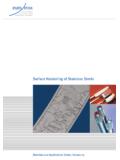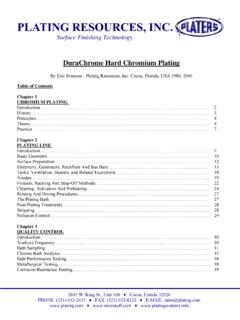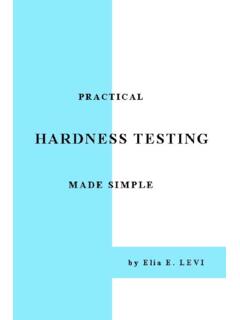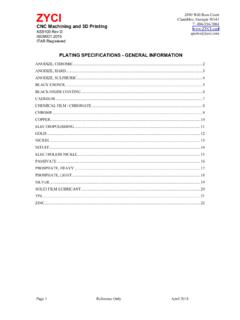Transcription of Predictive Models of Li-ion Battery Lifetime - NREL
1 nrel is a national laboratory of the Department of Energy, Office of Energy Efficiency and Renewable Energy, operated by the Alliance for Sustainable Energy, LLC. Predictive Models of Li-ion Battery Lifetime Kandler Smith, Eric Wood, Shriram Santhanagopalan, Gi-Heon Kim, Ying Shi, Ahmad Pesaran National Renewable Energy Laboratory Golden, Colorado IEEE Conference on Reliability Science for Advanced Materials and Devices Colorado School of Mines Golden, Colorado September 7-9, 2014 nrel /PR-5400-62813 2 Key Messages Semi-empirical Battery Lifetime Models are generally suitable for system design & control oLong-term validation still needed oStandardization would benefit industry oCharacterization requires expensive cell aging experiments Physics Lifetime Models are needed to reduce test time as well as guide future cell design oOpen questions remain how best to model electrochemo-thermo-mechanical processes across length- and time-scales Liu et al.
2 , J. Echem Soc. (2010) nrel Life & MSMD Models 3 Thermal nrel Electrochemical/Thermal/Life Models Multi-Scale Multi-Domain (MSMD) model Inter-domain coupling of field variables, source terms Efficient, flexible framework for physics expansion Leading approach for large-cell computer-aided engineering Models Kim et al. (2011) Multi-Domain Modeling of Lithium-Ion Batteries Encompassing Multi-Physics in Varied Length Scales , J. of Electrochemistry, Vol. 158, No. 8, pp. A955 A969 Electrochemical Current Collector (Cu)Current Collector (Al)pNegativeElectrodeSeparatorPositiveE lectrode4 Life- Predictive model Physics-based surrogate Models tuned to aging test data Implemented in system design studies & real-time control Regression to NCA, FeP, NMC chemistries 15 C20 C25 C30 C10 CMinneapolisHoustonPhoenixLi-ion graphite/nickelatelif e:PHEV20, 1 cycle/day 54% DoDNo coolingAir coolingAir cooling, low resistance cellPhoenix, AZ ambient conditions33 miles/day driving, 2 trips/dayLiquid cooling, chilled fluidIl l ustr ati on by Josh Bauer , N R ELNREL Electrochemical/Thermal/Life Models NCA = Nickel-Cobalt-Aluminum FeP = Iron Phosphate NMC = Nickel-Manganese-Cobalt 5 Outline Background Li-ion Batteries oWorking principles oElectrochemical window oDegradation mechanisms Life Predictive Modeling Automotive Life Studies & Control 6 Li+ VWorking Principles VNeg.
3 Electrode Graphite Hard carbon Silicon Titanate Li foil Pos. Electrode LiXO2, X = NiMnCo Co NiCoAl LiMn2O4, LiFeP04 7 Electrochemical Operating Window Potential vs. Li (V) SOC (x in LixC6 or y in Li1- ) 0% SOC 100% SOC Potential measured at cell terminals charge discharge Figure credit: Ilan Gur (ARPA-E) & Venkat Srinivasan (LBNL), 2007 8 Electrochemical Window Degradation Potential vs. Li (V) SOC (x in LixC6 or y in Li1- )O2) Figure credit: Ilan Gur (ARPA-E) & Venkat Srinivasan (LBNL) 2007 9 Negative Electrode Degradation (Graphite) Graphene layer Graphite exfoliation, cracking (gas formation, solvent co-intercalation) Electrolyte decomposition and SEI formation SEI conversion, stabilization and growth SEI dissolution, precipitation Positive/negative interactions Lithium plating and subsequent corrosion Donor solvent SEI Li+ 1) Manufacturing environment 2) Application environment i) graceful fade (time at high T,SOC) ii) sudden fade/ damage (cycling at low T) Figure credit: Vetter et al.
4 , Journal Power Sources, 2005 Negative/ electrolyte interactions 10 Positive Electrode Degradation (Metal Oxide) Positive/negative interactions X. Xiao et al., Echem Comm., 32 (2013) 31-34. Positive/electrolyte interactions Figure credit: Vetter et al., Journal Power Sources, 2005 11 Mechanical Coupled Stress & Degradation Least understood amongst ECTM physics Figure credit: Santhanagopalan, Smith, et al., Artech House (in press) 12 Mechanical Coupled Stress & Degradation Examples Cannarella, J. Power Sources (2014) Diercks, Packard, Smith et al., J. Echem Soc (2014) Figure credit: Santhanagopalan, Smith, et al., Artech House (in press) 13 Outline Background Li-ion Batteries Life Predictive Modeling oPhysics-based oSemi-empirical Automotive Life Studies & Control 14 Degradation Mechanism vs. Length Scale 10-10 10-8 10-6 10-4 10-2 10-0
5 Chemistry SEI growth Li plating Electrolyte decomposition Gas generation Particle scale SEI -cracking Fracture, damage of transport paths Phase evolution, voltage droop Electrode scale Electrode creep, delamination, isolation Separator pore closure Pore clogging Cell scale 3D elec, thermal, mech. inhomogeneities Tab effects Stack/wind Module scale Thermal & mechanical boundary conditions 15 Macro-scale Stress Model 10-10 10-8 10-6 10-4 10-2 10-0
6 Stress/strain due to thermal and electrode bulk concentration changes Coupled echem & thermal Behrou, Maute, Smith, ECS Mtg. (2014) 16 Micro-scale Stress/Degradation Model 10-10 10-8 10-6 10-4 10-2 10-0
7 Damage evolution Performance impact An, Barai, Smith, Mukherjee, JES 2014 17 nrel Life Predictive Model Data: Hall, IECEC, 2006. 17 Relative Capacity (%) Time (years) r2 = Li-ion NCA chemistry Arrhenius-Tafel-Wohler model describing a2( DOD,T, V) NCA Correct separation of calendar vs. cycling degradation for extrapolation of year testing to 10+ year life Extensible to untested drive cycles, environments (state form) Relative Resistance Relative Capacity Qsites = c0 + c2 N + .. R = a1 t z + a2 N Calendar fade SEI growth Loss of cyclable lithium Coupled with cycling a1, b1 = f( DOD,T,Voc,..) Q = min ( QLi , Qsites ) QLi = b0 + b1 t z +.
8 Cycling fade Active material structure degradation and mechanical fracture a2, c2 = f( DOD,T,Voc ,..) NCA 18 Knee in Fade Critical for Predicting End of Life Example simulation: 1 cycle/day at 25 C 50% DOD: Graceful fade controlled by Li loss ~ t1/2 80% DOD: Transitions to electrode site loss, N ~ 2300 cycles Life over-predicted by 25% without accounting for transition from Li loss (~chemical) to site loss (~mechanical) NCA Time (Days) 19 Electrode Site Loss Cell Aging Data Graphite/iron-phosphate meta-dataset from multiple labs FeP 20 Electrode Site Loss Cell Aging Data Graphite/iron-phosphate meta-dataset from multiple labs 13 of 50+ test conditions show apparent knee in capacity fade curve FeP 21 Electrode Site Loss Model (graphite/iron phosphate) ()()[]()()().expexp,, ,22 + + = refpulsepulserefrateraterefarefattCCTTET TRE refmTmDODmcc).,min(sitesLiqqq=NbtbbqzLi2 10++=Nccqsites20+=accelerated polymer failure at high T bulk intercalation strain bulk thermal strain intercalation gradient strain, accelerated by low temperature FeP Model successfully describes 13 aging conditions from 0 C to 60 C 22 Outline Background Li-ion Batteries Life Predictive Modeling Automotive Life Studies & Control oTemperature (xEV) oCharge control (xEV / grid) oPrognostic/duty-cycle control (xEV) 23 Ambient Effects on Battery Average Temperature 05101520253035 Phoenix, AZLos Angeles,CAMinneapolis,MNTemperature (C) BEV75 Passive cooling Average Ambientw/ solar effectsw/ driving effects05101520253035 Phoenix, AZLos Angeles,CAMinneapolis,MNTemperature (C)
9 PHEV35 Chilled liquid cooling Average Ambientw/ solar effectsw/ driving + active TMS Ambient conditions dominate Thermal connection with passenger cabin, parking in shaded structures strongly influence Battery life Battery temperature and Lifetime weakly coupled to ambient conditions 24 Optimized Charging Strategies Reduce time spent at high SOC (delay charging) Avoid high C-rates to lower peak temperatures Cost function CU-Boulder/Hoke (2014) 25 Optimized Charging Strategies Delayed charging best Begin charge End charge A) Constant energy cost Response to price signals No V2G energy exported until electricity price $ Begin charge End charge B) Variable energy cost 26 nrel ARPA-E AMPED Projects in Battery Control 26 Utah State/Ford Project: 20% reduction in PHEV pack energy content via power shuttling system and control of disparate cells to homogenous end-of-life nrel : Requirements analysis; life model of Ford/Panasonic cell; controls validation of Ford PHEV packs Eaton Corporation Project: Downsized HEV pack by 50% through enabling Battery prognostic & supervisory control while maintaining same HEV performance & life nrel : Life testing/modeling of Eaton cells; controls validation on Eaton HEV packs Washington Univ.
10 Project: Improve available energy at the cell level by 20% based on real-time Predictive modeling & adaptive techniques nrel : Physics-based cell-level Models for MPC; implement WU reformulated Models on BMS; validate at cell & module level AMPED = Advanced Management and Protection of Energy Storage Devices 27 nrel ARPA-E AMPED Projects in Battery Control Utah State/Ford Project: 20% reduction in PHEV pack energy content via power shuttling system and control of disparate cells to homogenous end-of-life nrel : Requirements analysis; life model of Ford/Panasonic cell; controls validation of Ford PHEV packs 1C Energy (Wh) Teardown analysis of automotive pack aged to 70% remaining energy shows variation at EOL variation at EOL Active balancing most benefits energy applications with large cell-to-cell disparity Key question: How much does cell-to-cell disparity grow with age? Extreme driving conditions, large pack T cause abnormally large cell capacity imbalance growth 28 Summary Main factors controlling Battery Lifetime oTime at high T & SOC (weak coupling with DOD & C-rate) oCycling at high DOD Low/high T & SOC Semi-empirical Battery Lifetime Models are generally suitable for system design & control oNREL Models describe various commercial chemistries oLife extensions of 20% to 50% may be possible Physics Lifetime Models to provide design feedback oElectrochemical/thermal processes well understood oMechanics coupling underway at various length scales 29 Funding US Dept.
















